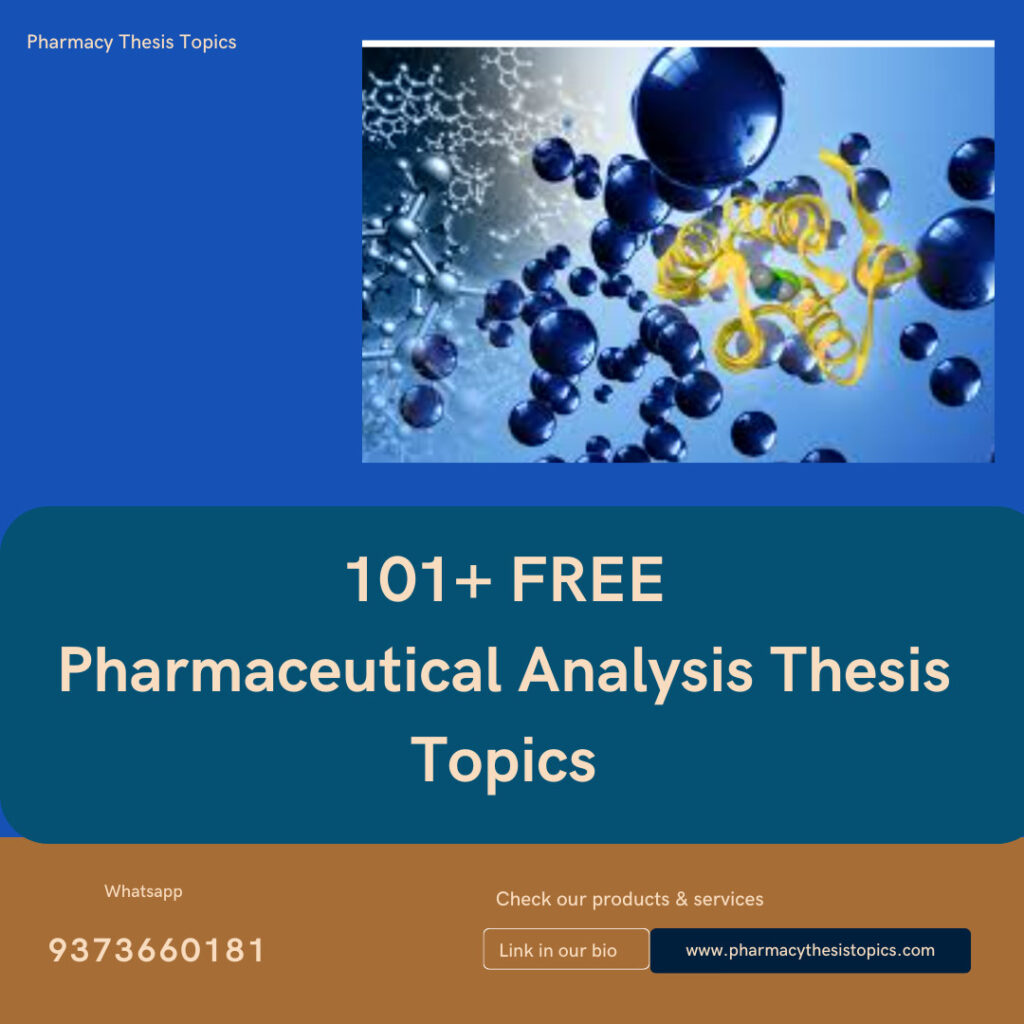Comparative evaluation of UV and HPLC methods for the quantification of paracetamol in pharmaceutical formulations.
Comparative study of stability-indicating methods for the analysis of ciprofloxacin under stress conditions.
Comparative analysis of dissolution profiles of sustained-release and immediate-release formulations of diclofenac sodium.
Comparative study on the determination of impurities in amlodipine tablets using HPLC and capillary electrophoresis.
Comparative evaluation of gas chromatography and HPLC techniques for residual solvent analysis in bulk drugs.
Comparative study of bioanalytical methods for the quantification of metformin in plasma.
Comparative validation of UV spectrophotometric and HPLC methods for quantifying aspirin in combination dosage forms.
Comparative study of potentiometric and HPLC methods for the assay of atenolol in bulk drugs.
Comparative analysis of natural and synthetic antioxidants using chromatographic techniques.
Comparative evaluation of reversed-phase HPLC and ion-exchange chromatography for the analysis of amino acids in protein hydrolysates.
Comparative study of two different dissolution apparatus for evaluating drug release from controlled-release formulations.
Comparative analysis of impurities in generic versus branded pharmaceutical products using advanced chromatographic techniques.
Comparative study of headspace gas chromatography and solid-phase microextraction for volatile organic compound analysis.
Comparative validation of high-performance thin-layer chromatography and HPLC for simultaneous estimation of multicomponent drugs.
Comparative evaluation of FTIR and Raman spectroscopy for the identification of polymorphic forms of drugs.
Comparative study of spectrophotometric and chromatographic methods for the analysis of phenolic compounds in herbal extracts.
Comparative analysis of tablet coatings using scanning electron microscopy and infrared spectroscopy.
Comparative evaluation of capillary electrophoresis and HPLC for the separation of enantiomers in pharmaceutical compounds.
Comparative study of dissolution profiles of different brands of ibuprofen tablets available in India.
Comparative evaluation of in vitro and in silico methods for predicting drug-excipient compatibility.
Comparative analysis of pharmaceutical excipients from natural and synthetic sources using advanced techniques.
Comparative validation of UV spectrophotometric and chromatographic methods for analyzing herbal extracts.
Comparative study of drug release from matrix and reservoir systems using dissolution techniques.
Comparative evaluation of thermal analysis techniques for the determination of stability of pharmaceutical formulations.
Comparative analysis of water content in pharmaceutical products using Karl Fischer titration and thermogravimetric analysis.
Comparative validation of fluorescence spectroscopy and HPLC methods for analyzing fluorescent drug compounds.
Comparative study of various ion-pairing agents in the HPLC analysis of acidic drugs.
Comparative evaluation of microwave digestion and wet digestion for heavy metal analysis in pharmaceuticals.
Comparative analysis of impurities in active pharmaceutical ingredients sourced from different manufacturers.
Comparative study of isocratic and gradient methods in HPLC for the quantification of multicomponent drugs.
Development and validation of a stability-indicating method for the analysis of antidiabetic drugs in bulk and tablet forms.
Analytical method development and validation for simultaneous estimation of antihypertensive drugs in fixed-dose combinations.
Assessment of drug-excipient interactions in pharmaceutical formulations using thermal analysis techniques.
Development of a chromatographic method for the quantification of alkaloids in herbal formulations.
Identification and quantification of impurities in antibiotics using advanced chromatographic methods.
Method development for the analysis of preservatives in parenteral formulations using HPLC.
Validation of a stability-indicating HPLC method for analyzing degradation products of anticancer drugs.
Quantitative determination of heavy metals in herbal medicines using atomic absorption spectroscopy.
Method development and validation for analyzing residual solvents in pharmaceutical formulations using gas chromatography.
Analytical method development for the quantification of flavonoids in polyherbal formulations.
Investigation of the dissolution behavior of poorly water-soluble drugs using modified dissolution media.
Development and validation of spectrophotometric methods for analyzing colorants in pharmaceutical products.
Evaluation of the effects of storage conditions on the stability of vitamin C in liquid formulations.
Development of a simple and rapid HPLC method for the determination of active ingredients in ophthalmic preparations.
Analytical study of drug-polymer interactions in sustained-release formulations.
Identification and quantification of pesticide residues in herbal raw materials using chromatographic techniques.
Stability-indicating method development for the analysis of proton pump inhibitors under forced degradation conditions.
Evaluation of counterfeit pharmaceutical products using spectroscopic and chromatographic techniques.
Determination of antioxidant activity in herbal extracts using HPLC and spectrophotometric methods.
Analytical method development for simultaneous estimation of analgesic and antipyretic drugs in fixed-dose combinations.
Determination of pharmacokinetic parameters of herbal drugs using bioanalytical methods.
Validation of a method for analyzing preservatives in cosmetic formulations using HPLC.
Analysis of drug degradation pathways in aqueous media using chromatographic and spectroscopic techniques.
Development of a rapid analytical method for the quantification of organic acids in syrups.
Study of polymorphic forms of drugs using differential scanning calorimetry and X-ray diffraction techniques.
Identification and quantification of saponins in herbal formulations using chromatographic methods.
Analytical validation of residual antibiotic activity in dairy products using chromatographic techniques.
Method development for the quantification of caffeine in energy drinks using spectrophotometric and chromatographic techniques.
Stability-indicating method development for analyzing fixed-dose combinations of antibiotics.
Validation of an analytical method for the estimation of preservatives in herbal cosmetics.
Development and validation of a dissolution test method for herbal capsules.
Analytical evaluation of heavy metals in pharmaceutical raw materials using atomic emission spectroscopy.
Development of a stability-indicating method for the analysis of cardiovascular drugs in plasma samples.
Validation of analytical methods for the quantification of alkaloids in herbal raw materials.
Analytical evaluation of volatile oils in medicinal plants using gas chromatography-mass spectrometry.
Development and validation of a chromatographic method for the estimation of curcuminoids in turmeric formulations.
Study of the degradation kinetics of antihypertensive drugs under different storage conditions.
Analytical method development for the determination of total phenolic content in herbal formulations.
Identification of counterfeit herbal supplements using analytical fingerprinting techniques.
Quantification of essential minerals in dietary supplements using inductively coupled plasma spectroscopy.
Development of a method for the analysis of glucosinolates in cruciferous vegetables using chromatographic techniques.
Validation of analytical methods for the estimation of active ingredients in transdermal patches.
Evaluation of the impact of formulation excipients on the stability of protein-based drugs.
Analytical method development for the quantification of bioactive compounds in green tea.
Determination of the solubility profile of poorly water-soluble drugs using analytical techniques.
Validation of a stability-indicating method for analyzing corticosteroids in cream formulations.
Identification and quantification of anthocyanins in fruits using HPLC.
Development of an analytical method for the quantification of tannins in polyherbal formulations.
Validation of analytical methods for the analysis of essential oils in aromatherapy products.
Analytical evaluation of drug release kinetics from nanoparticle-based formulations.
Study of the effects of pH on the stability of amino acids in liquid formulations.
Analytical method development for the determination of residual monomers in polymeric materials.
Stability-indicating method development for analyzing peptides in pharmaceutical formulations.
Analytical validation of a method for the quantification of preservatives in liquid pharmaceutical preparations.
Analytical evaluation of dissolution profiles of oral thin films using UV spectrophotometry.
Development of a stability-indicating method for analyzing fixed-dose combinations of antimalarial drugs.
Determination of pharmacokinetic parameters of liposomal formulations using analytical techniques.
Validation of analytical methods for analyzing flavonoids in fruit extracts.
Quantification of active ingredients in herbal teas using chromatographic techniques.
Analytical method development for the estimation of glycosides in plant-based formulations.
Development of a rapid method for the quantification of residual solvents in herbal extracts.
Validation of an analytical method for the determination of vitamins in fortified food products.
Analytical evaluation of the effects of temperature on the stability of vaccines.
Development of a method for the quantification of lignans in herbal raw materials.
Study of the impact of solvent systems on the extraction efficiency of bioactive compounds.
Validation of analytical methods for the quantification of beta-carotene in functional foods.
Development of an analytical method for the determination of alkaloids in energy drinks.
Evaluation of the stability of pharmaceutical formulations under accelerated conditions.
Analytical method development for the quantification of bioactive peptides in protein supplements.
Validation of a stability-indicating method for analyzing herbal creams and ointments.
Determination of drug release profiles from hydrogel-based drug delivery systems using advanced techniques.



